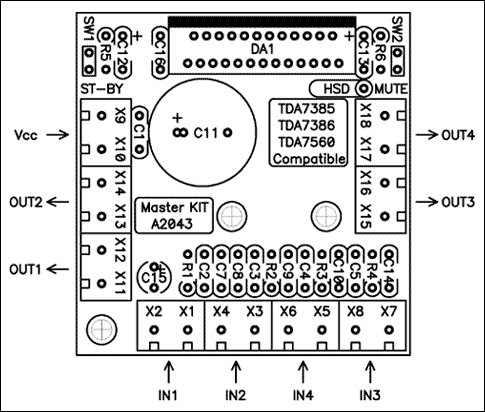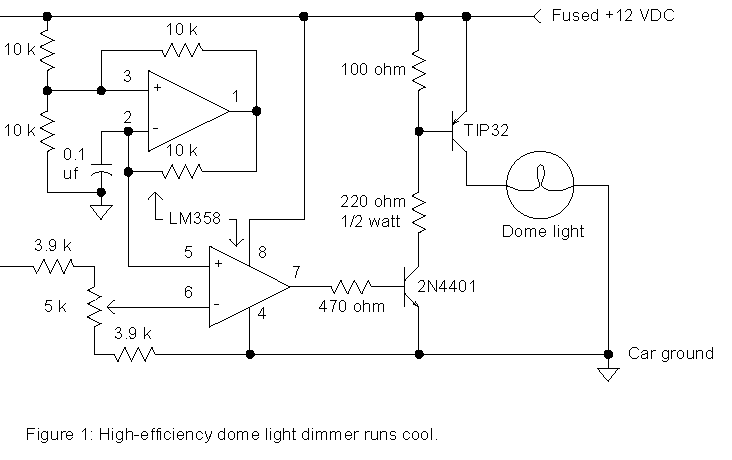Technical Specifications - Characteristics
Working voltage: 12V DC
Current: 30 mA
How it Works
As it has already been stated the circuit consists of an ultrasonic transmitter and a receiver both of which work at the same frequency. They use ultrasonic piezoelectric transducers as output and input devices respectively and their frequency of operation is determined by the particular devices in use.
The transmitter is built around two NAND gates of the four found in IC3 which are used here wired as inverters and in the particular circuit they form a multivibrator the output of which drives the transducer. The trimmer P2 adjusts the output frequency of the transmitter and for greater efficiency it should be made the same as the frequency of resonance of the transducers in use. The receiver similarly uses a transducer to receive the signals that are reflected back to it the output of which is amplified by the transistor TR3, and IC1 which is a 741 op-amp. The output of IC1 is taken to the non inverting input of IC2 the amplification factor of which is adjusted by means of P1. The circuit is adjusted in such a way as to stay in balance as long the same as the output frequency of the transmitter. If there is some movement in the area covered by the ultrasonic emission the signal
that is reflected back to the receiver becomes distorted and the circuit is thrown out of balance. The output of IC2 changes abruptly and the Schmitt trigger circuit which is built around the remaining two gates in IC3 is triggered. This drives the output transistors TR1,2 which in turn give a signal to the alarm system or if there is a relay connected to the circuit, in series with the collector of TR1, it becomes activated. The circuit works from 9-12 VDC and can be used with batteries or a power supply.
Ultra Sonic Radar Circuit diagram
Construction
First of all let us consider a few basics in building electronic circuits on a printed circuit board. The board is made of a thin insulating material clad with a thin layer of conductive copper that is shaped in such a way as to form the necessary conductors between the various components of the circuit. The use of a properly designed printed circuit board is very desirable as it speeds construction up considerably and reduces the possibility of making errors. Smart Kit boards also come pre-drilled and with the outline of the components and their identification printed on the component side to make construction easier.
To protect the board during storage from oxidation and assure it gets to you in perfect condition the copper is tinned during manufacturing and covered with a special varnish that protects it from getting oxidised and also makes soldering easier. Soldering the components to the board is the only way to build your circuit and from the way you do it depends greatly your success or failure. This work is not very difficult and if you stick to a few rules you should have no problems. The soldering iron that you use must be light and its power should not exceed the 25 Watts. The tip should be fine and must be kept clean at all times.
For this purpose come very handy specially made sponges that are kept wet and from time to time you can wipe the hot tip on them to remove all the residues that tend to accumulate on it. DO NOT file or sandpaper a dirty or worn out tip. If the tip cannot be cleaned, replace it. There are many different types of solder in the market and you should choose a good quality one that contains the necessary flux in its core, to assure a perfect joint every time. DO NOT use soldering flux apart from that which is already included in your solder. Too much flux can cause many problems and is one of the main causes of circuit malfunction. If nevertheless you have to use extra flux, as it is the case when you have to tin copper wires, clean it very thoroughly after you finish your work. In order to solder a component correctly you should do the following:
@Clean the component leads with a small piece of emery paper.
@Bend them at the correct distance from the component’s body and insert the component in its place on the board.
@You may find sometimes a component with heavier gauge leads than usual, that are too thick to enter in the holes of the p.c. board.
@In this case use a mini drill to enlarge the holes slightly. Do not make the holes too large as this is going to make soldering difficult afterwards.
@Take the hot iron and place its tip on the component lead while holding the end of the solder wire at the point where the lead emerges from the board. The iron tip must touch the lead slightly above the p.c. board.
@When the solder starts to melt and flow wait till it covers evenly the area around the hole and the flux boils and gets out from underneath the solder. The whole operation should not take more than 5 seconds. Remove the iron and allow the solder to cool naturally without blowing on it or moving the component. If everything was done properly the surface of the joint must have a bright metallic finish and its edges should be smoothly ended on the component lead and the board track. If the solder looks dull, cracked,or has the shape of a blob then you have made a dry joint and you should remove the solder (with a pump, or a solder wick) and redo it.
@Take care not to overheat the tracks as it is very easy to lift them from the board and break them.
@When you are soldering a sensitive component it is good practice to hold the lead from the component side of the board with a pair of long-nose pliers to divert any heat that could possibly damage the component.
@Make sure that you do not use more solder than it is necessary as you are running the risk of short-circuiting adjacent tracks on the board, especially if they are very close together.
@When you finish your work cut off the excess of the component leads and clean the board thoroughly with a suitable solvent to remove all flux residues that may still remain on it.
@There are quite a few components in the circuit and you should be careful to avoid mistakes that will be difficult to trace and repair afterwards. Solder first the pins and the IC sockets and then following if that is possible the parts list the resistors the trimmers and the capacitors paying particular attention to the correct orientation of the electrolytic.
@Solder then the transistors and the diodes taking care not to overheat them during soldering. The transducers should be positioned in such a way as they do not affect each other directly because this will reduce the efficiency of the circuit. When you finish soldering, check your work to make sure that you have done everything properly, and then insert the IC’s in their sockets paying attention to their correct orientation and handling IC3 with great care as it is of the CMOS type and can be damaged quite easily by static discharges. Do not take it out of its aluminium foil wrapper till it is time to insert it in its socket, ground the board and your body to discharge static electricity and then insert the IC carefully in its socket. In the kit you will find a LED and a resistor of 560 — which will help you to make the necessary adjustments to the circuit. Connect the resistor in series with the LED and then connect them between point 9 of the circuit and the positive supply rail (point 1).
Connect the power supply across points 1 (+) and 2 (-) of the p.c. board and put P1 at roughly its middle position. Turn then P2 slowly till the LED lights when you move your fingers slightly in front of the transducers. If you have a frequency counter then you can make a much more accurate adjustment of the circuit. Connect the frequency counter across the transducer and adjust P2 till the frequency of the oscillator is exactly the same as the resonant frequency of the transducer. Adjust then P1 for maximum sensitivity. Connecting together pins 7 & 8 on the p.c. board will make the circuit to stay triggered till it is manually reset after an alarm. This can be very useful if you want to know that there was an attempt to enter in the place which are protected by the radar.



Adjustments
This kit does not need any adjustments, if you follow the building instructions.
Warning
If they are used as part of a larger assembly and any damage is caused, our company bears no responsibility.
While using electrical parts, handle power supply and equipment with great care, following safety standards as described by international specs and regulations.
If it does not work
Check your work for possible dry joints, bridges across adjacent tracks or soldering flux residues that usually cause problems. Check again all the external connections to and from the circuit to see if there is a mistake there.
See that there are no components missing or inserted in the wrong places.
Make sure that all the polarised components have been soldered the right way round. Make sure that the supply has the correct voltage and is connected the right way round to your circuit. Check your project for faulty or damaged components.
If everything checks and your project still fails to work, please contact your retailer and the Smart Kit Service will repair it for you.
Parts
R1 180 KOhm
R2 12 KOhm
R3, 8 47 KOhm
R4 3,9 KOhm
R5, 6, 16 10 KOhm
R7, 10, 12, 14, 17 100 KΩ
R9, 11 1 MOhm
R13, 15 3,3 KOhm
C1, C6 10uF/16V
C2 47uF/16V
C3 4,7 pF
C4, C7 1 nF
C5 10nF
C8, C11 4,7 uF/16V
C9 22uF/16V
C10 100 nF
C12 2,2 uF/16V
C13 3,3nF
C14 47nF
TR1, 2, 3 BC547 , BC548
P1 10 KOhm trimmer
P2 47 KOhm trimmer
IC1, 2 741 OP-AMP
IC3 4093 C-MOS
R TRANSDUCER 40KHz
T TRANSDUCER 40KHz
D1, 2, 3, 4 1N4148

 4 x 35W Car Audio Amplifier TDA7383
4 x 35W Car Audio Amplifier TDA7383







